As our world continues to evolve, so do our modern workplaces. With economic uncertainty, layoffs and mounting global pressures, new internal communications trends emerge in the face of tremendous evolution.
The past year has been a period of profound transformation for organizations worldwide. Amid economic uncertainties, the acceleration of digital transformation, and an increasing emphasis on mental health and diversity, internal communications pros are being asked to navigate a complex and rapidly changing environment.
In 2026, the traditional approaches to internal communication are being redefined, with a focus on agility, personalization, and inclusivity. As we look ahead, it’s clear that staying attuned to the latest internal communications trends will be essential for organizations aiming to connect with their workforce in meaningful ways and drive long-term success.
This post explores the top internal communication trends of this year, highlighting how these practices are shaping the future of work and redefining how organizations engage with their employees. From AI-powered tools to hyper-personalized messaging using internal email software, and a renewed focus on trust-building and employee well-being, here are a few employee communication trends aligned with the evolving needs of a modern workforce.
Take a self-guided tour of ContactMonkey
See how our key features can streamline your internal communications.
Take product tour

1. Internal Communications at the Forefront of Change Management
The concept of “change” is ubiquitous in corporate dialogues, and understandably so—hardly any organization is immune to it. However, we’re shifting the focus away from traditional change management discourse to emphasize a crucial component: communication is not just a part of change management; it’s fundamental to its success. To understand this employee communication trend, we summarize below:
- Leadership is essential: Change cannot occur without proactive and positive leadership.
- Consistency is key: Reinforce key messages frequently to ensure they stick.
- Emotional resonance: True change goes beyond mere information; it must connect on an emotional level to be effective.
- Communication is critical: Successful change management is impossible without robust communication strategies.
Given the longstanding emphasis on change management, here’s a pivotal stance for 2026: As a best practice for internal comms, no change initiative should begin without the active involvement of internal communications.
Moreover, it’s time to move away from treating internal communication as an afterthought or a remedy for faltering transformations. Instead, teams should involve communication professionals right from the onset. Not to mention, if an organization is dealing with a crisis, engaging internal comms early is especially important which would require a crisis management plan.
2. Internal Communications Becomes the #1 Trust-Building Tool in Uncertain Times
The challenge of discerning reliable content in today’s digital age is real. Every day, we encounter the vast ocean of information that bombards us daily, often leading us to accept narratives without verifying their authenticity.
As part of the latest internal comms trend, internal communicators have the unique opportunity to foster a controlled environment free from the pressures of clickbait and advertising. The focus is on meticulous research and providing clear, accurate information, which is crucial in mitigating uncertainty and building trust.
The role of internal comms isn’t to overwhelm with an incessant flow of content but to deliver consistent, truthful, and empathetic communication that assures and secures our employees’ trust in both the information and the company itself.
This commitment to creating a calming information environment not only strengthens trust within the organization but also positions internal comms teams as dependable stewards of information.
Modern internal comms and measurement tools
No design or technical expertise needed. Save time, increase engagement, and dazzle your employees with fun and interactive communications.
Explore all features

3. The People Experience (PX) Takes Center Stage
Whether it’s called the HR department, labor management, HR management, or the PX department, People Experience embodies a strategic mindset integral to a company’s overarching philosophy and strategy. PX represents a comprehensive approach aimed at shaping how employees feel about their workplace.
Consequently, internal communication, alongside other key functions like leadership, IT, training, and healthcare, plays a vital and central role in this strategy. To enhance our understanding and implementation of PX as an internal comms trend, here are nine key elements essential for a robust People Experience:
PEOPLE
- Leadership: Focused on the role of leaders in shaping the workplace experience.
- Team: Highlighting the importance of team dynamics and collaboration.
- Relationships: Emphasizing the value of building strong interpersonal connections at work.
WORKPLACE
- Culture: Pertains to the overarching environment and ethos of the company.
- New work: Related to emerging work practices and innovative ways of working.
- Basics: Covers the fundamental aspects and conditions of the workplace.
ME
- Purpose: Concerns the individual’s understanding of their role and its impact.
- Own tasks: Focuses on personal responsibilities and job functions.
- Growth: Involves opportunities for personal and professional development.
These elements should be acknowledged and supported by both HR and internal communications as they cover diverse areas where HR and internal comms can exert significant influence.
This year, the primary responsibilities of internal communications include managing various platforms and channels, crafting compelling narratives, organizing essential content and information, supporting with digital employee onboarding, and facilitating both virtual and physical interactions, relationships, and opportunities for exchange.
For internal communicators, there’s a duty to leverage skills and insights to shape the People Experience in a way that ensures employees feel valued and respected. From top management down, you’ll have the chance to forge and reinforce transparent, honest, respectful, and relevant corporate communication. This strengthens employee well-being and fosters a deep sense of belonging, positioning PX as a cornerstone of organizational success – all powered by internal communicators!
TIP: Email collaboration software has plenty of benefits and can help you execute on the full-range of internal comms responsibilities.
4. Best Practices Emerge for Artificial Intelligence and Internal Comms
Think about the possibilities: Artificial intelligence systems that not only understand the nuances of language but can also craft compelling content, create perfect headlines, and save countless hours of research. It’s truly remarkable what ChatGPT for internal communications and similar tools have brought to the table. In 2026, a digital trend in employee communication includes the synergy between AI and internal comms complement each other beautifully though it’s important to approach AI with care.
Wait, what does using AI with care mean exactly?
Fact-check, fact-check, fact-check: As distinguishing between genuine and counterfeit content on social media grows tougher, it is crucial to own the content creation process, control the narrative, and verify the accuracy of AI-generated content.
Participate actively in crafting AI guidelines: Similar to the early days of social media, it’s key that communication teams are involved in shaping the guidelines for AI use to ensure they are part of the conversation from the start.
Leverage AI to streamline your workflow and inspire your creativity: When used effectively, AI for internal communications can significantly reduce time spent on routine tasks, help overcome writer’s block by quickly generating content, and enhance creativity in brainstorming sessions. By using targeted prompts with tools like ChatGPT, AI can assist in research and suggest innovative titles and conclusions.
Enhance your AI expertise: Deepen your understanding of AI and position yourself as a go-to AI expert within your organization. Lean on your managers and colleagues and educate them about the advantages and opportunities of artificial intelligence. Embrace generative AI without fear, using it to make informed business decisions and solidify your role as a pivotal player in the evolution of internal communications.
Watch ContactMonkey LIVE in action
Join live demo
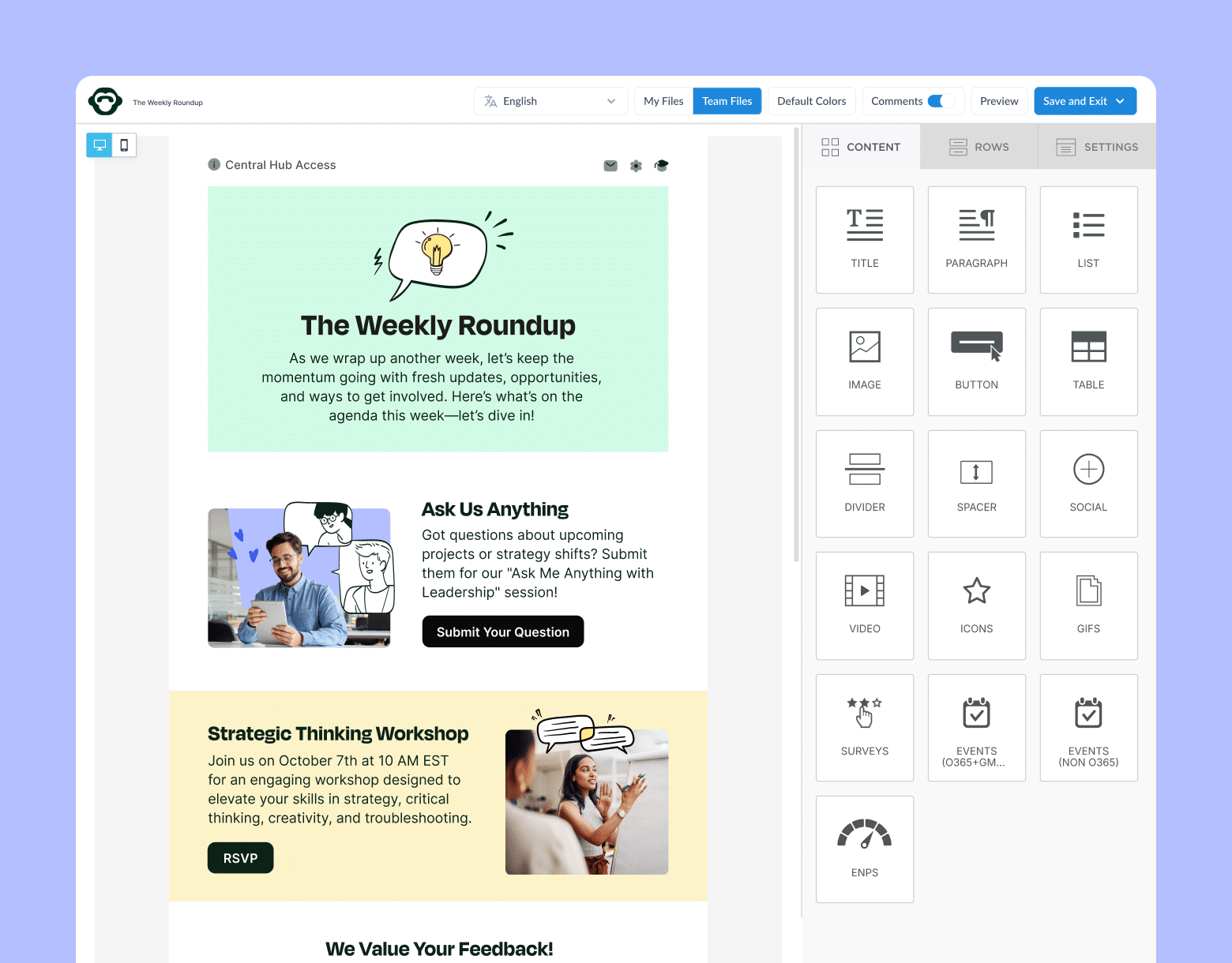
5. Rising Popularity of Video-First Internal Communication
Video content is increasingly becoming a preferred medium for everything from internal announcements to training modules, providing a vibrant and engaging way to communicate with employees.
Videos for internal comms stand out by engaging both visual and auditory senses, making them more impactful and memorable than text alone. This dual sensory engagement is especially useful for delivering crucial announcements or explaining complex training materials, as it enhances understanding and retention. Additionally, videos have the capability to convey emotions and subtle nuances, infusing a personal and relatable touch into internal communications.
Organizations are now embracing a variety of tools and platforms that facilitate the creation and distribution of video content. User-friendly video editing tools like Adobe Premiere Rush and Canva allow virtually anyone to produce polished videos. Using an employee communications platform, these videos can be widely disseminated, fostering advocacy for both internal and external content. These platforms also offer insights into viewer engagement through detailed analytics (yes, that’s right – you can measure the impact of your videos with analytics!).
As the internal comms trend towards video content gains momentum, it’s clear that organizations must integrate this dynamic communication tool to maintain effective engagement with their workforce. Whether for disseminating vital information, conducting training, or enhancing community spirit within the company, video content is becoming an essential element in the toolkit of internal communications.
6. Advancement of Personalization in Employee Comms
The concept of hyper-personalization, or the ‘Internet of Me,’ is transforming the landscape of internal communications by tailoring content to the individual needs and preferences of employees, moving beyond traditional, one-size-fits-all approaches.
This current trend in internal communications goes beyond just addressing employees by their first names in emails. It involves leveraging data and behavioral analytics to craft content that truly resonates with each individual. In a world where intranet news feeds and training recommendations are customized based on each employee’s interactions and interests, this means that personalized communication will significantly boost employee engagement and satisfaction. When employees receive information that is directly relevant to them, their connection with the organization strengthens, enhancing not only the effectiveness of communication but also the employees’ sense of value within the company.
Implementing this level of personalization requires advanced data analysis capabilities and sophisticated technology. Organizations need to utilize analytics and AI to discern employee preferences and tailor content accordingly.
While the advantages of personalization are clear, it also presents challenges, including data privacy concerns and the need to maintain inclusivity. Organizations must manage these challenges by ensuring ethical data practices and accommodating the diverse needs of their entire workforce.
Get powerful email analytics and reporting features
Know exactly who is opening and engaging with your employee communications and company newsletters.
Explore analytics & reporting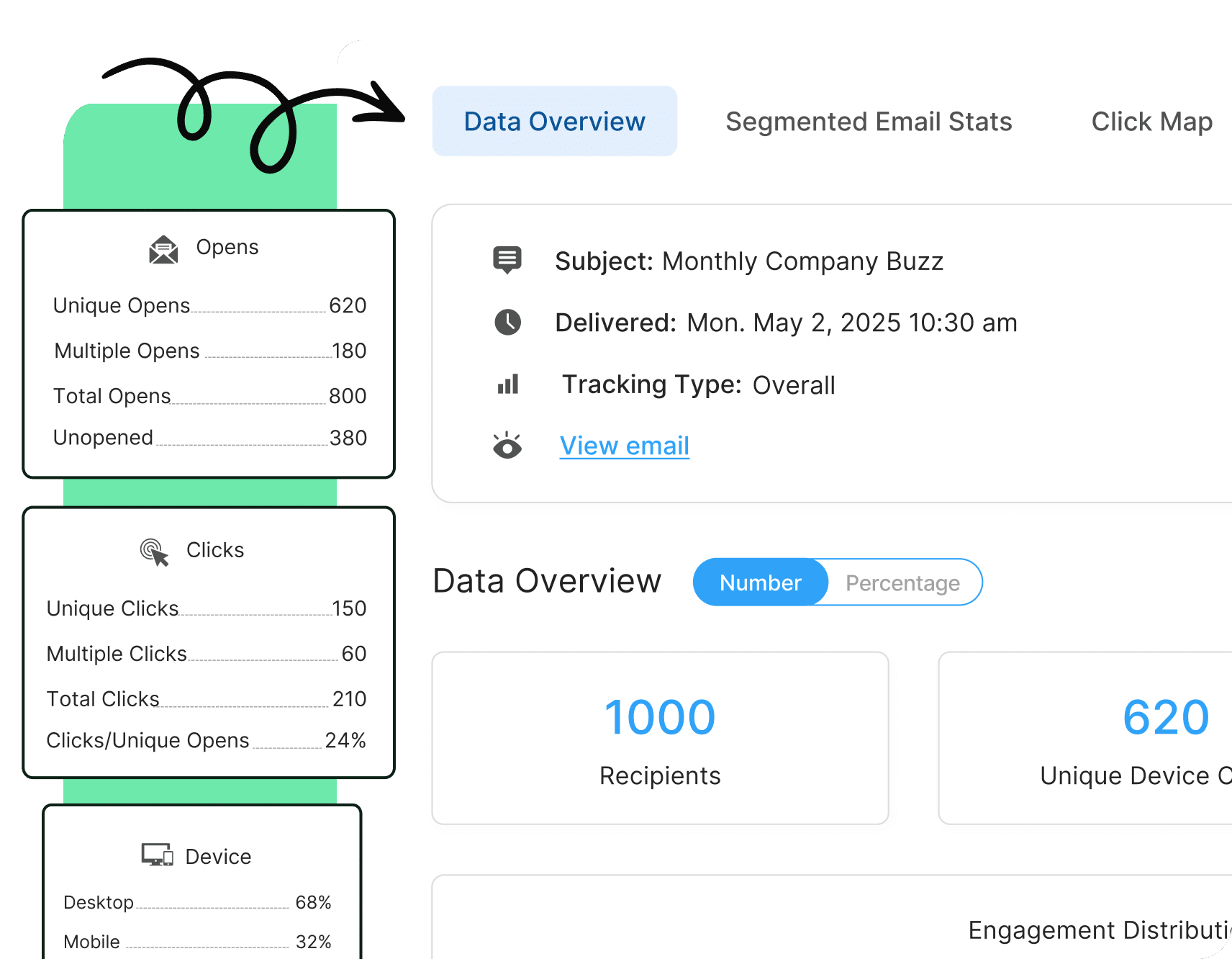
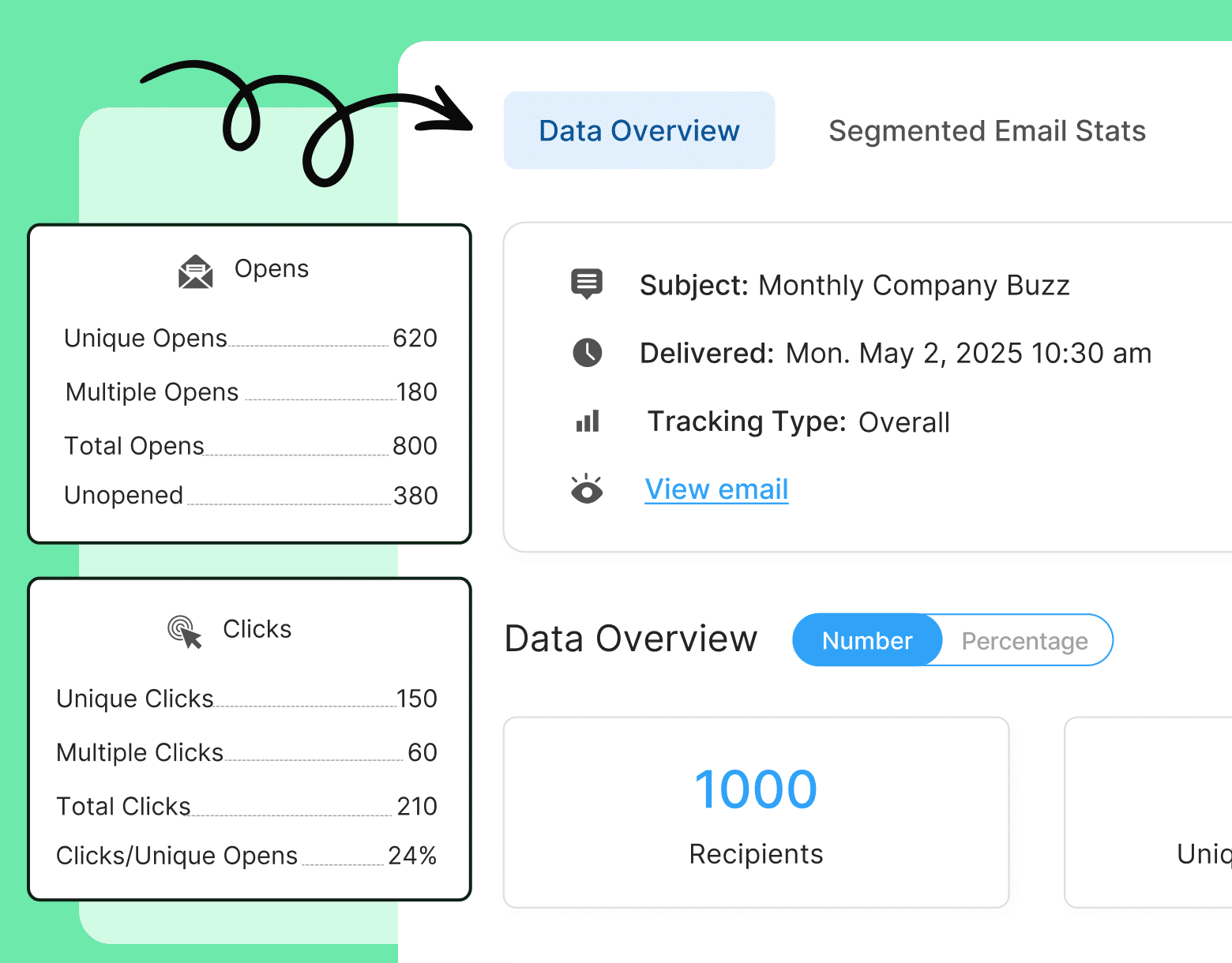
7. Internal Communications Inspires Diversity, Equity and Inclusion (DE&I)
Hiring managers often emphasize the importance of candidates who align well with the company’s culture. However, it’s equally important for communicators to consider how they can help shape an organizational culture that prioritizes inclusivity.
Language has a dual power: it can either connect people or divide them. The words we choose and the way we communicate can significantly impact an individual’s sense of belonging. By fostering inclusive communication, we can positively influence workplace culture, encouraging employees to fully engage and contribute their unique perspectives and skills.
Inclusive communication not only helps employees feel respected and valued, but it also boosts their confidence to actively participate in achieving the organization’s goals. This sense of belonging can lead to higher engagement and motivation, which in turn enhances performance and customer satisfaction.
What is inclusive language?
Inclusive language aims to eliminate biases and avoid phrases that might discriminate based on race, gender, socioeconomic status, or ability. It strives to connect broadly by using impartial and respectful terms.
What ISN’T inclusive language?
It’s not about political correctness or avoiding every potential error. Instead, it’s about empathy, accuracy, relevance, and respect. Inclusive language should not feel restrictive but should celebrate diversity and foster a culture where everyone feels they belong.
How communicators can promote inclusivity through language:
- Language audits and revisions: Conduct a full internal communications audit —inclusive of job postings, marketing materials, internal memos, and digital content—to identify and modify language that may imply bias. This involves replacing gender-specific terms with neutral ones and avoiding generalizations that use exclusive language.
- Training and awareness: Conduct training sessions to raise awareness about the importance of inclusive language. Equip employees with the knowledge to recognize and correct biased language.
- Feedback mechanisms: Implement systems where employees can provide feedback on the inclusivity of communications. This feedback should be used to continually refine language use.
- Inclusive storytelling: Share diverse stories and experiences from various team members to highlight the range of voices within the organization. This helps to normalize diversity and inclusion within the corporate narrative.
- Consistent application: Ensure that inclusive language is part of every communication channel, from formal HR documentation to casual internal chats. Consistency is key to embedding inclusivity into the organizational culture.
By integrating these strategies, communicators can lead the way in building an inclusive workplace where every employee feels valued and has the opportunity to thrive.
8. Enhancing Internal Communications with Centralized Content for Mental Health and Well-being
The latest trends in internal communications highlight the growing importance of mental health and well-being in the workplace. As the impact of mental health on employee performance and satisfaction becomes more apparent, companies are integrating well-being strategies into their internal communication plans. In 2026, corporate internal communications trends focus on promoting mental health awareness and providing resources to support employee well-being.
Centralized content, such as training materials on mental health, is invaluable for internal communications as it standardizes the message about the importance of mental wellness in the workplace. By leveraging an employee app, internal communications teams can efficiently distribute e-learning tools that broaden employees’ understanding of and ability to cope with mental health issues at work.
This emerging trend in internal communications not only educates but also empowers managers through targeted training, enabling them to support their teams effectively and promote a healthier work environment. Such tools are essential for fostering a supportive culture that prioritizes mental well-being.
The use of an employee app to share varied multimedia content—including videos, animated GIFs, and surveys—plays a crucial role in engaging employees and providing consistent education on mental health. Featuring videos of executive leadership discussing their personal struggles can greatly humanize the topic and encourage open conversation, reinforcing the message that mental health is a priority at all levels of the organization.
Furthermore, the inclusion of evidence-based mental health promotion tools like mindfulness exercises and physical fitness resources via the app ensures all staff members have easy access to supportive content. This centralized approach not only enhances the accessibility and effectiveness of internal communications but also significantly supports the overall well-being of the workforce, positioning the organization as a caring and responsive employer.
As the conversation around mental health continues to evolve, internal communicators must stay ahead of this trend in internal communications.
BONUS: Check out what a Mental Health Awareness Month communications toolkit could look like at your organization.
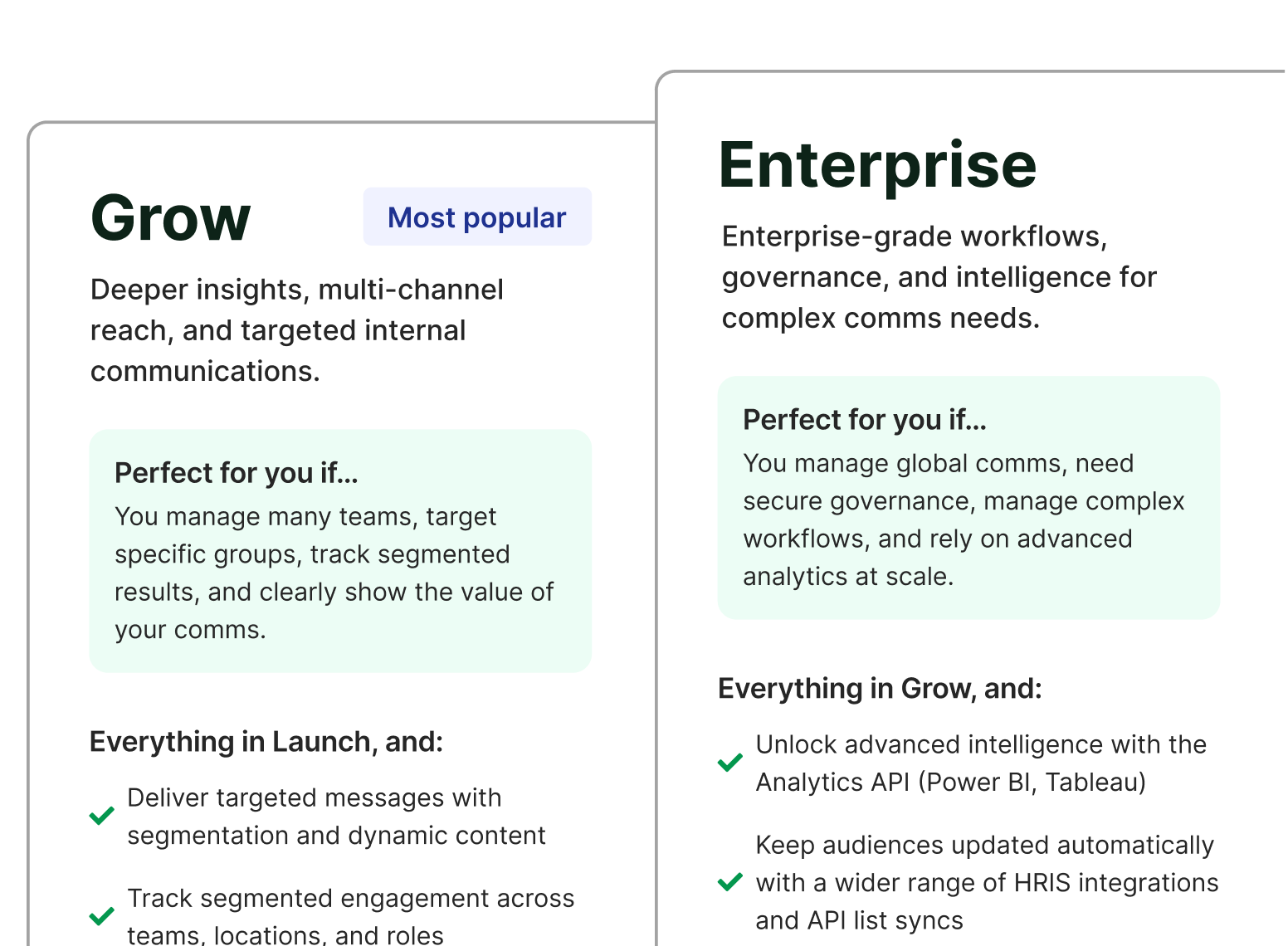
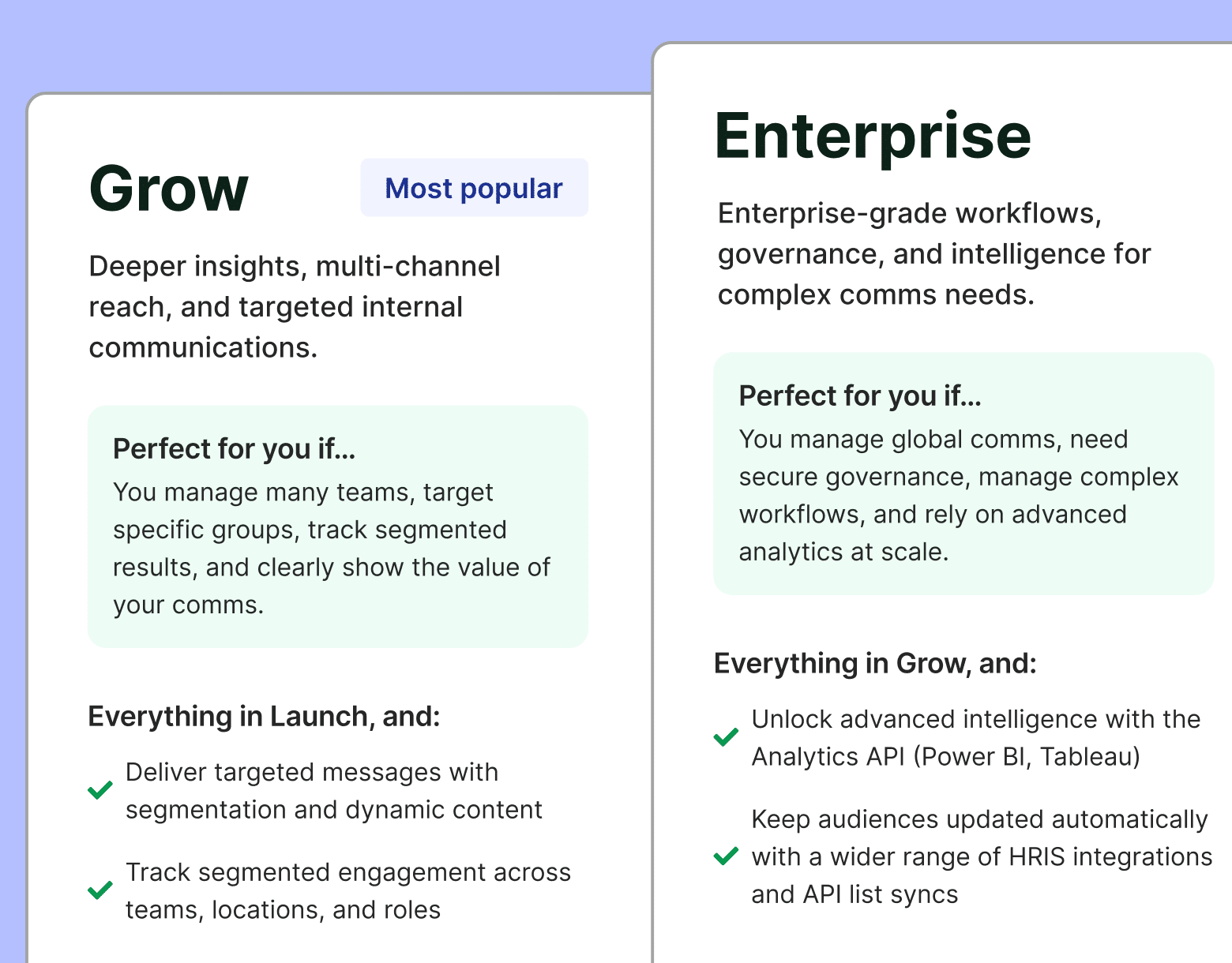
9. Understanding Storytelling vs. Narrative in Internal Communication
To grasp this internal communication new trend, it’s crucial to distinguish between storytelling and narrative. In essence, “storytelling is the means, while narrative is the end.”
This concept implies that narrative provides the overarching framework within which individual stories are told. Typically, these stories are shaped by personal concerns, essentially asking, “What does this story mean for ME and how does it influence MY actions?”
Consider the release of the latest iPhone model. A timeline of events, in summary:
- Tech reviewers praise its advanced camera features and innovative display technology.
- Friends share their excitement about the phone’s enhanced battery life and sleek design.
- It’s reported as having the fastest processor ever in a smartphone.
- Social media influencers showcase its capabilities in various real-world scenarios.
And then, we start to see a narrative form: “I need to get the new iPhone to stay ahead with the latest in technology and innovation!”
This scenario illustrates how individual stories about the iPhone’s features and user experiences contribute to a compelling narrative that emphasizes staying technologically current and enjoying a premium user experience. Narratives like these effectively motivate consumers to align their personal tech choices with the perceived advancements and status the new iPhone offers.
Knowing the difference between storytelling and narratives helps you deploy strategic internal communications, supporting with the improvement of internal comms at your organization.
10. Boosting Engagement with Cutting-Edge Tools and Strategic Integrations
As remote and hybrid work models continue to redefine the workplace, traditional internal communication methods are evolving to meet new demands. Yes, email is still very much in play, but organizations are now turning to internal collaboration tools, internal comms tech, and integrations to enhance engagement levels among their teams. These tools not only encourage participation through gamification and interactive features, making employees feel more connected to the corporate community, but they also generate valuable data that helps track and analyze engagement effectively.
Automation is transforming internal communications by streamlining processes, increasing efficiency, and creating more personalized experiences. It is imperative that management actively supports the integration of automation, providing the necessary resources, setting clear objectives, and fostering a collaborative work environment across functions.
Here’s how automation is revolutionizing internal communications:
- Multi-channel distribution: Automation allows for the seamless distribution of messages across various platforms such as emails, messaging apps, intranets, and social media. This ensures that communications reach employees timely and consistently, catering to their preferred channels.
- Scheduled content delivery: With tools for scheduling and workflow automation, organizations can plan and execute communications strategies efficiently. This not only ensures consistency in content delivery but also helps in maintaining high engagement levels among employees.
- Analytics and measurement: Automated tools facilitate the collection and analysis of data, providing insights into how effectively messages are reaching employees and engaging them. This data is crucial for making informed decisions that can refine communication strategies and help optimize your internal communication campaigns.
- Personalized communication: Automation enables the customization of messages based on specific employee data like job roles, locations, and interests. Personalized communications significantly boost engagement by making employees feel valued and understood.
By leveraging these advanced tools and techniques, companies can significantly improve how they connect with and engage their employees, ensuring that internal communications are not only effective but also integral to fostering a vibrant and inclusive corporate culture.
Do you like to learn as much as you can about internal comms? Read our guide to internal communication research that covers the key topics and questions to ask.
Access a Strategic Advantage with ContactMonkey
Staying on top of internal comms trends can be a full-time job for some. ContactMonkey gives you the opportunity to focus your efforts on the big picture and alleviates the time-consuming content creation process, the building and deployment of emails (get pre-built templates!) and analyzing data.
Our tool offers you provides a strategic advantage through a seamless Outlook and Gmail integration, facilitating the creation of engaging, professionally designed emails efficiently. This integration also ensures that communications are not only consistent with the brand but also visually appealing.
In terms of ContactMonkey’s real-time analytics capability, this allows internal communicators to monitor open rates, link clicks, and overall engagement without the manual lift. Plus, this immediate feedback helps identify what content resonates best with employees, enabling the continuous optimization of communication strategies.
ContactMonkey also supports interactive elements like polls and surveys directly within emails, enhancing employee engagement by making it easy for staff to provide feedback and opinions without leaving their inbox. This direct line of communication fosters a more responsive and inclusive corporate culture, positioning ContactMonkey as a crucial tool for modern internal communications strategies.
ContactMonkey’s all-in-one internal communications software can help you try out new internal communications trends, see what works, and ditch what doesn’t. To see how our solution can support a futureproof internal communications strategy, book your free demo today.



